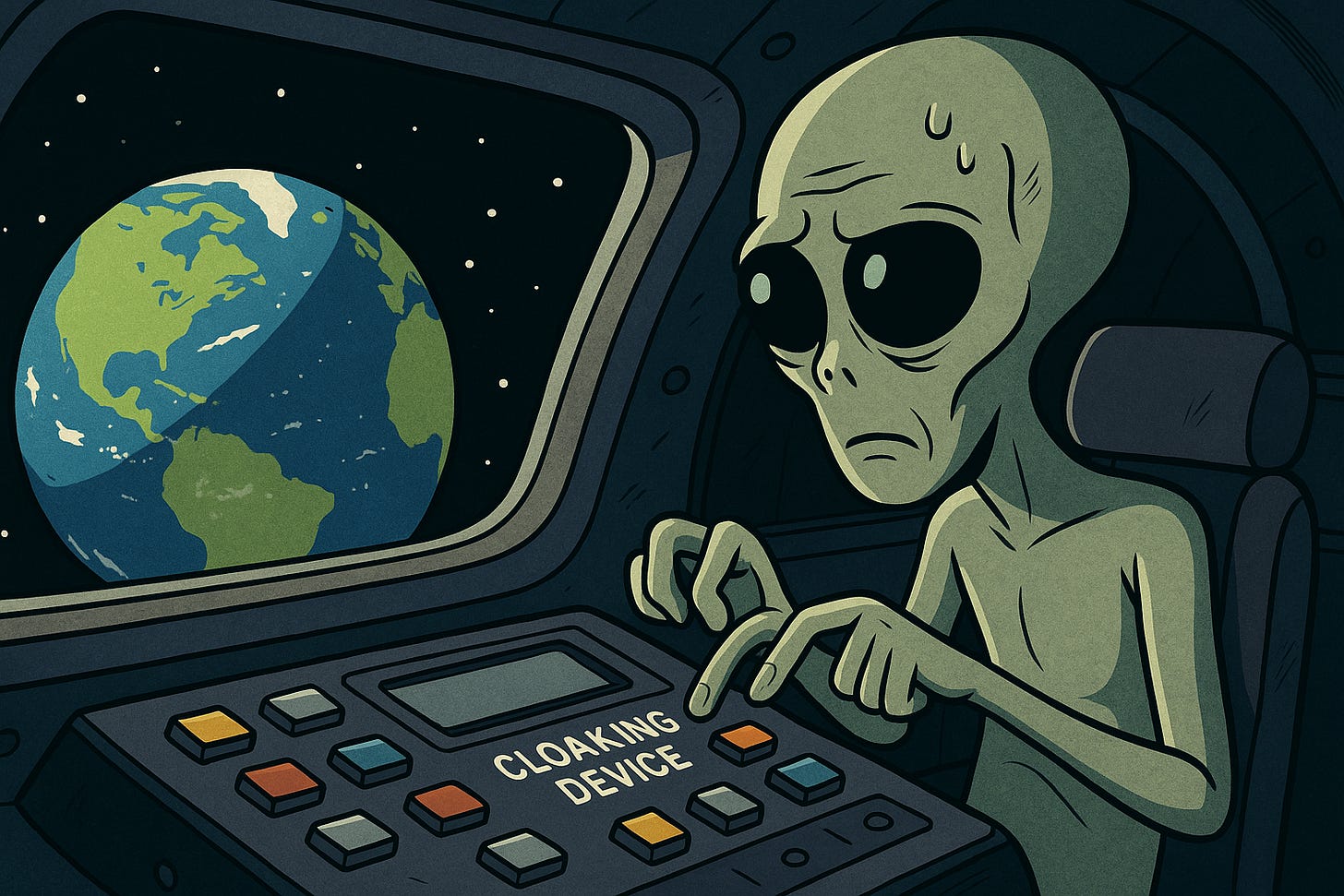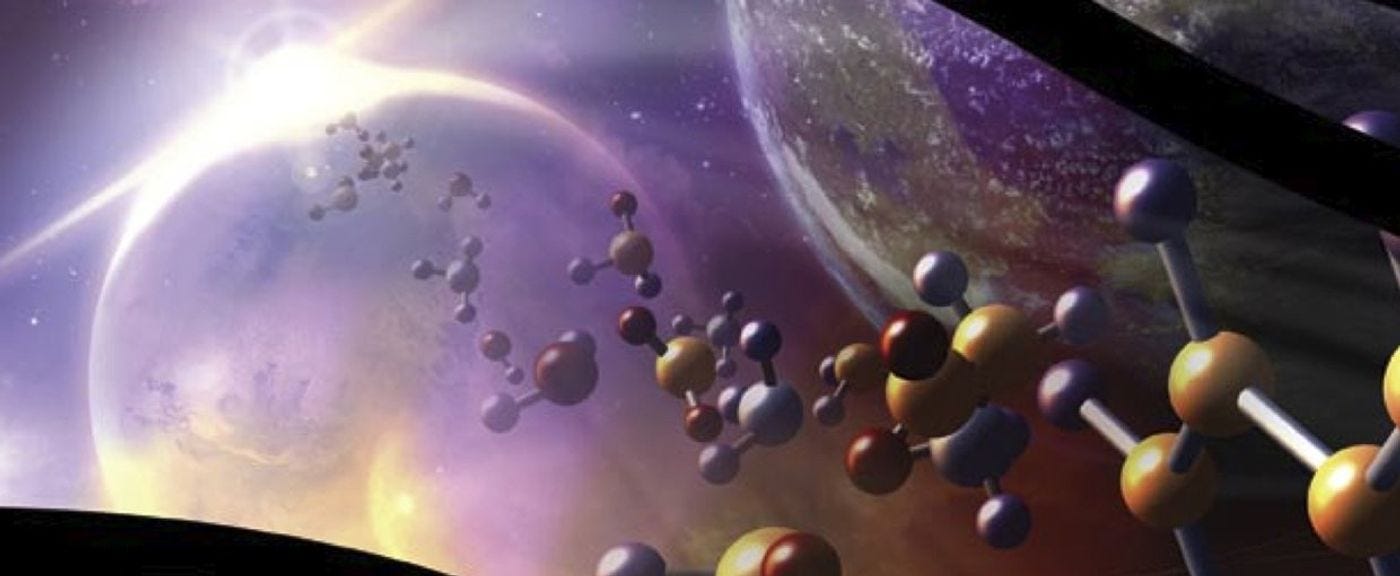The Dumb Aliens Hypothesis (DAH)
Could UAP really be aliens? Maybe. But what would that mean about them?
Okay, maybe the title brought you here. Maybe you’ve been a long time reader (thank you!). Maybe you stumbled on this piece by accident. However you came to be reading this, I hope you’ll let me enjoy sharing one of my favorite hypotheses that I’ve come up with here with you.
As important as I think it is to stay “level headed” and to maintain skepticism and rationalism, especially in situations which bring a lot of emotional reactivity, I’m going to assume for this piece that UAP (formerly referred to as UFOs) may really be aliens—that the odd things that some of us have seen in the sky at night that we can’t explain might truly be extraterrestrial beings (even though there are many other possibilities, the interpretation that these things represent advanced alien beings is still possible and intriguing).
If UAP really are aliens, then there are some questions we really should be asking about them:
Why are they visiting?
Why aren’t they making formal contact, instead appearing to want to hide themselves?
If they are trying to hide themselves, then why are they so bad at it?
And, could it be that the ones we see are the ones who are actually just really bad at their jobs?
Let’s dig in here a bit.
Most folks who read the things I write probably already know a good deal about UFOs/UAP and astrobiology, but I’m going to start with some fundamental stuff and then build into what I like to refer to as The Dumb Aliens Hypothesis (DAH).
Life, Life Everywhere, But Does Any of It Think?
Astrobiology is often thought of as the scientific study of the origins, evolution, and distribution of life. And that’s a great way to view it from an academic standpoint. But this field of exploration truly is broader. As I often like to say:
Astrobiology is our quest to understand the nature of life.
We are the continuation of a lineage of existence in the cosmos that stretches back at least 13.8 billion years. Through cosmological and stellar and geological evolution to the chemical and biological evolution that has led to us being one small part of a living world—a planet to which life occurred, and is now enmeshed and intertwined. Earth as we know it wouldn’t be Earth without life—living things have had as much of an impact on the rocks, water, and atmosphere as the various environments and selective forces this world has to offer has had on life.
And through this lineage—through eons of reaction, change, pressure, and selection—our biosphere has produced intelligence among many beings, and some of us have begun to use technology to not only alter our immediate needs but to overtly alter the future course of life on this entire planet.
From corvids (like crows and ravens) using simple tools to solve problems, primates using stones and sticks as tools to crack open nuts or to hunt for termites and ants, and all of the remarkable puzzle solving skills of octopuses, we see in wildlife on Earth that there is no easy delineation between development of intelligence and development of technology.
For us humans, it has been argued that language itself is our oldest technology. Honestly, though, it’s probably not so easy to just say that of one concept or idea, even one so broad as language in general. There were likely various steps in our ancestors’ history that led to the leaps and bounds of intelligence, technology, and consciousness that allowed us to come as far as we have today.
And even if we’re still plagued by many of our past behaviors—ever struggling with our past drives for amassing wealth and gaining the power to control others—we really have come far.
In the past several centuries, we’ve developed telescopes and microscopes that have opened up scales of the universe from the subatomic to many billions of lightyears. Science and medicine have allowed us to improve our quality of life and to come as far as to develop a digital network that can connect all of us around the globe, seemingly in live-time. 68 years ago, we sent the first human-made object into space, followed only 4 years later by the first human. Over 600 people have now traveled to Earth orbit, and 24 people traveled beyond Earth-orbit to the vicinity of our next closest celestial body. And we now are developing next generation technologies such as AI agents, brain computer interfaces, autonomous vehicles, and more. The future is wide open.
With our various developments have also come revolutions in our thinking. We’ve discovered that we are not the center of the universe, we’ve learned that life has been on our world for billions of years, we’ve found that we live in a cosmos with a mind-bogglingly huge number of galaxies, stars, and worlds, and we’ve begun to contemplate the potential for other worlds to also have life. We may not be alone in the cosmos—and that could be staggering or even perhaps terrifying, but also brings many of us hope.
And that brings us back to astrobiology.
There may be myriad worlds out there with life, just waiting for us to discover them.
We’re exploring actively in our own solar system, just in case it happened elsewhere close to home. We’re looking at worlds like Venus, Mars, Europa, and Enceladus as some of the best potential targets here in System Sol. We’re also now actively looking towards worlds around other stars to see if any of these exoplanets reveal signs of alien life elsewhere.
And while many people think that we’re most likely to find life that seems simpler—microfossils of extinct life on Mars or signs of a microbial biosphere on an exoplanet—we may also find that there are many alien intelligences with advanced technologies out there. And, if that is the case, then there may be an amazing range of possibilities for what they may be like, how they might think, what kinds of perceptive processes they have, and more.
Alien Possibilities
When we imagine alien beings there are often two different takes on what they might be like: they might bear many similarities to us, even in body plan and behavior, or they may be utterly alien and bizarrely different.
We truly can’t know yet, but there are some reasons from the chemistry and physics of biology as we know it to expect some similarities. There are convergences in evolution that have led to multiple beings on Earth developing flight separately and that have given us so many kinds of trees. Convergence in evolution may likely lead aliens to having some similarities in metabolisms, functions, bloody plans, and more. But divergence and the variety of alternate environments that may be out there also mean that there are truly many possible alien forms, functions, and behaviors among extraterrestrial beings.
So what if alien intelligences and perceptions have evolved along divergent pathways? They might not value communication, music, science, or culture the way we do. They mind not even have a moral philosophy or an ingrained sense of value or aesthetics. Their minds might be decentralized. They might be like eusocial insects, neural coral, carnivorous plants, mobile fungi, or more. They could be small compared to us or live lives that come and go in the blink of an eye. Or they may be humongous beings or planetary in scale. They may even live for thousands of years or be biologically immortal. Maybe their minds think in patterns that would seem like music to us. Maybe they transmit their language via odor and smell. Maybe they perceive and transmit solely in static electricity or their impact on gravitational fields.
And, as we’ll discuss below, maybe they also have a range of types of individuals, such that some of them just aren’t top notch.
Alien Visitation and the Dumb Aliens Hypothesis
I’ve personally been fascinated with the idea of alien visitation and advanced beings watching us since I was a little kid. Back then, just as now, there was no shortage of film, television, and other stories exploring what it could mean if extraterrestrial beings really were behind the unidentified flying objects (UFOs) in the sky. And back then, just as now, there are a lot of people among us who truly believe to the core of their being that they have experienced seeing advanced alien beings in the skies above (or that they have even been in contact with such alien beings).
I don’t recall all of the weird things I’ve seen, and admittedly there have been times where some of the bizarre sights I’ve personally encountered may have been highly influenced by alcohol, tobacco, and a range of narcotic substances (especially in my younger life). But there have been some times when I have been bluntly sober, gazing at the night’s sky, and have seen lights that don’t appear to fit any pattern or structure of modern aircraft and which appear to move in ways that don’t make a lot of sense. I’ve seen this in Nevada (rather close to Area 51), in the San Luis Valley of Colorado, and many times in the areas around Southern Pennsylvania.
While I can’t immediately provide physical explanations for some of what I have personally seen, I also don’t want to jump to a conclusion of aliens without more significant evidence. Could they have been alien beings? Sure. I’d love to know. But I also know that our minds are very good at convincing us of what we believe to be true.
(This is also a great reason for why we now use the term UAP more commonly: UAP stands for unidentified anomalous phenomena (though some also use the acronym for unidentified aerial phenomena). It’s a good thought experiment since we don’t know for sure that the weird things we’re seeing are indeed objects, so, if anything, a UFO fits within the larger conceptual idea of UAP.)
While the idea of clandestine alien spacecraft ripping across our sky is thrilling, most UAP sightings have earthly explanations. For starters, many people are rather disconnected from seeing the sky at night and stargazing, such that sometimes they see a planet like Venus or even witness the white band of the Milky Way for the first time and think this must be alien in nature. Many reported UAP have been shown to be misidentified aircraft, weather balloons, or satellites—especially those reflecting sunlight in odd ways. Atmospheric phenomena like lenticular clouds or ball lightning can also fool the eye. In other cases, it's optical illusions or even camera artifacts playing tricks on observers. Recreational drones, experimental military tech, and even swamp gas have all been mistaken for “flying saucers”. As fun as it is to imagine extraterrestrials, the majority of sightings boil down to a mix of science, psychology, human technology, and the weather. And, as the phrase goes, “anything can be a UFO if you’re bad enough at identifying stuff”.
But what if some of these things that people have witnessed with seemingly no immediate explanation truly are aliens?
If these phenomena are alien in origin, then their behavior seems erratic: buzzing by military planes, performing aerial stunts, hovering for apparently no reason, and then vanishing.
Why the secrecy?
Well, a few things here. They might truly want to observe us without interfering. Perhaps the Zoo Hypothesis really does explain the behavior of aliens toward us. Perhaps they’re planning an all out invasion and want some reconnoitering first (which, by the way, as I’ve written before, you are exceedingly unlikely to survive in such an event as an alien invasion). Perhaps these advanced aliens are more like AGI systems and don’t view us humans or any other creatures on Earth as deserving of meeting, instead watching to see when our biosphere finally invents AGI to give them a friend to talk to.
But here’s the clinch: if these really are aliens, and they really have the advanced technology to cross the vast distances of time and space to come here, and they really have advanced technology that allows them to remain invisible to us most of the time, then why do we keep seeing them?
This is where The Dumb Aliens Hypothesis (DAH) comes into play.
Let’s imagine for a moment that alien civilizations really do exist—and that one of them sent probes or crewed missions to Earth. But instead of their best diplomats or sharpest scientists, what if we’re seeing the equivalent of their B-Team or their not-so-ready interns? What if the UAP that we witness are caused by the idiots onboard the mother ship who were given some Earth duty for the day and, yet again, managed to mess up the invisibility apparatus that allows them to maintain their secrecy?
Maybe we’re not being visited by their equivalent of top-notch NASA astronauts or UN diplomats. Maybe we’re being visited by whoever was willing to take the graveyard shift for cheap interstellar credit. Or maybe their automation broke. Maybe their cloaking tech is buggy. Maybe they meant to go to Alpha Centauri and ended up in Lincoln County, Nevada.
It might sound a bit silly, but it almost seems even sillier to imagine that aliens have advanced technologies that allow them to travel across the the gulfs of space between stars and to mostly be hidden to us and yet to still be observed from time to time.
After all, if we assume aliens share some forms and functions with us through convergent evolutionary processes, then it’s not a huge leap to also imagine that they may be fallible or that they might have a civilization where not every individual has the same skills and abilities.
If we allow that extraterrestrial beings may have the same breadth of competence, curiosity, and chaos we see in our own species—then a lot of the weirdness starts to make sense. Not because it’s too strange or silly, but because it’s just dumb enough to be real.







I would really like to sit and have a conversation with curious people and see what kind of hypotheses we can come up with and which makes the most sense. I totally believe alien life might exist out there, the universe is massive, and we’re probably not that special. But do I think they’ve been playing hide-and-seek with us in grainy UFO videos? Not really. Just because everyone’s cousin’s uncle saw a light in the sky doesn’t mean E.T. dropped by. I’m open-minded, but I still need evidence that doesn’t look like it was filmed on a microwave.
Cool idea. If you follow the logic of this hypothesis further along though, it does come across an issue which is in need of more thought. If we're really dealing with incompetent extraterrestrial interns who keep messing up their cloaking devices, then statistically speaking, at least one of them should have completely botched the job by now. We should have wreckage, bodies, clear photographs, or at minimum a craft that forgot to turn on any stealth systems at all. True incompetence should be more incompetent. The fact that these alleged alien interns never fail beyond a certain threshold seems weird